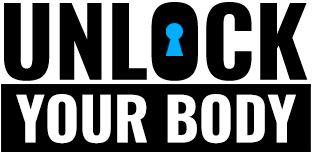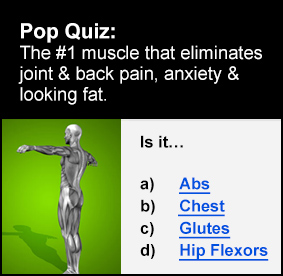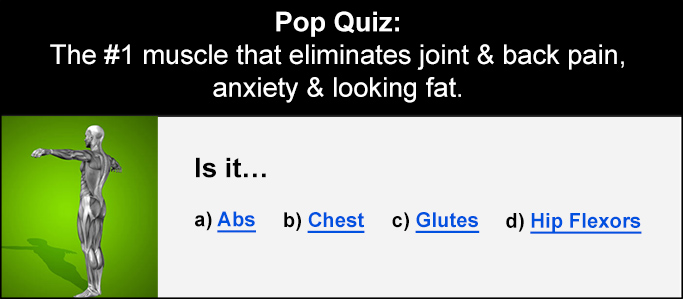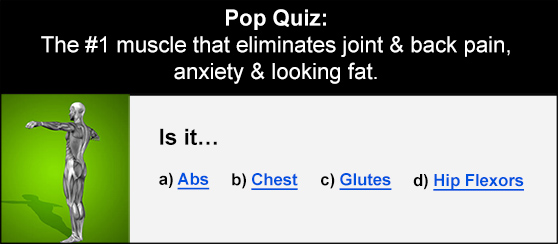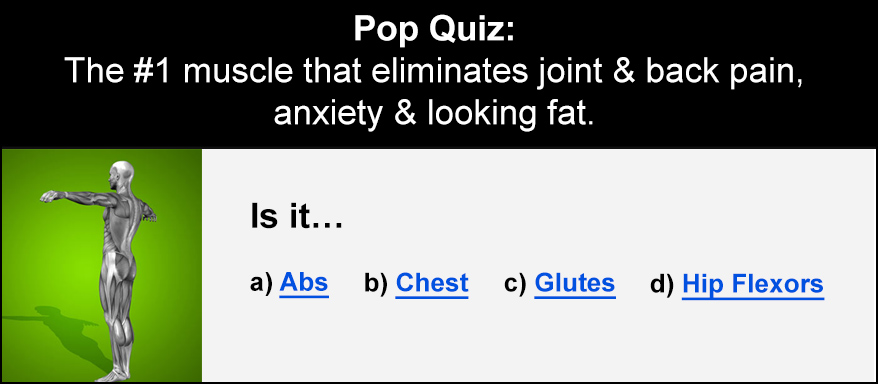Feeling stiff, stressed, and low on energy?
You’re not alone. In our fast-paced, screen-filled world, stress manifests in our bodies as tight shoulders, a stiff lower back, [1] and persistent fatigue. [2] We rush through the day, only to collapse into bed with tension we never fully release.
But what if you could break that cycle, in just a few minutes a day?
These 7 gentle, low-impact moves are designed to help you:
- Release daily stress from joints and muscles.
- Improve flexibility and mobility (without intense workouts)
- Calm your nervous system naturally.
- Feel lighter, looser, and more in control of your health.
- Support consistent stretching for stress relief practices to unwind both body and mind
Whether you’re recovering from injury, managing chronic tightness, or just need a break from the chaos, this short routine offers relief that lasts—and results that are both noticeable and lasting.
Let’s dive in.
1. Cat-Cow Stretch
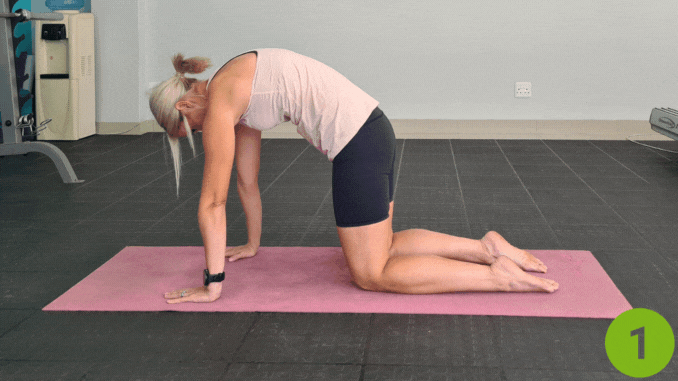
Benefit: Loosens spine, relieves back tension, improves breathing rhythm
Why it works: Rhythmic spinal motion eases nervous system overload while gently improving spine mobility.
- Begin in a 4-point position with your hands beneath your shoulders and your knees under your hips.
- Engage your core. Arch your back, lifting your chest, and gaze upward on an inhale.
- Exhale as you tuck your pelvis, round your spine, and lower your head toward your chest.
- Repeat this sequence for 1–2 minutes or as needed.
To intensify, add circular motions by gently rotating your hips and shoulders
2. Seated Forward Fold
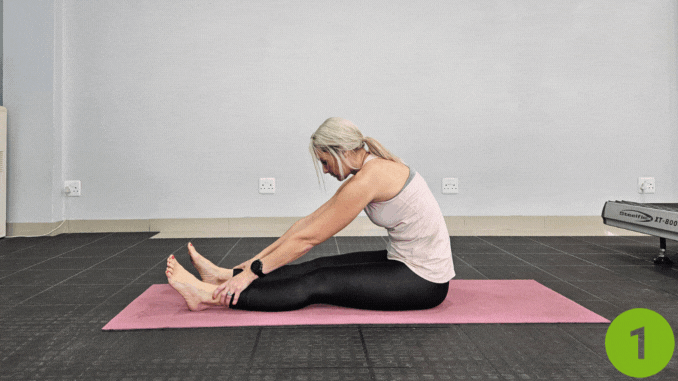
Benefit: Stretches hamstrings, relaxes the mind, improves flexibility in the back and hips.
- Begin in an upright sitting position on the floor with your legs extended.
- Maintain good alignment with your upper body. Place your hands at your side.
- Inhale to lengthen your spine, then exhale and fold forward from the hips, letting your hands reach toward your toes.
- Avoid forcing the stretch to prevent injury.
- Hold for 30 seconds to 1 minute.
Pro tip: Keep a slight bend in the knees to avoid strain. This is about release, not reaching.
3. Chest Opener With Deep Breathing
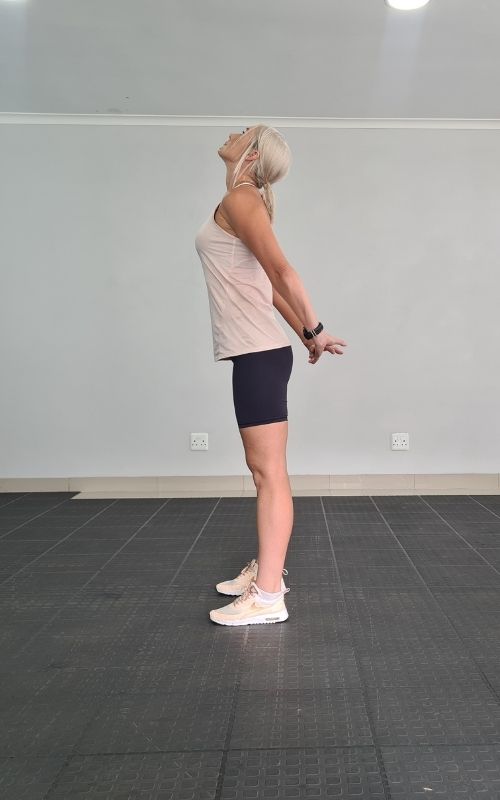
Benefit: Opens tight chest muscles, reduces shallow breathing, and encourages calm.
- Begin in an upright standing position with your feet hip-width apart, maintaining good alignment with your head, shoulders, hips, and legs.
- Clasp your hands behind your back, straighten your arms, and gently lift your chest.
- Hold the position for several deep belly breaths, inhaling through your nose and exhaling through your mouth.
- Relax, then repeat for 5 deep breaths.
Quick win: Great for reversing “desk posture” and encouraging a sense of openness and emotional uplift.
4. Supine Twist
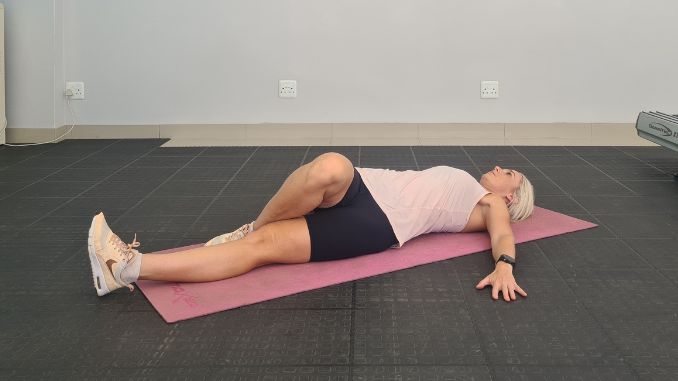
Benefit: Releases low back tension, aids digestion, enhances relaxation, and improves spinal mobility
- Lie on your back on the floor with your legs extended.
- Maintain good alignment with your head, shoulders, hips, and legs. Place your hands at your side.
- Engage your core to support the spine.
- Bend one knee and drop the knee to one side as you look in the opposite direction.
- Hold the position for several deep belly breaths, in through your nose and out through your mouth.
- Relax and repeat the movement on the opposite side.
Bonus: This is a go-to move for better sleep if done before bed.
5. Standing Forward Bend (Ragdoll Pose)
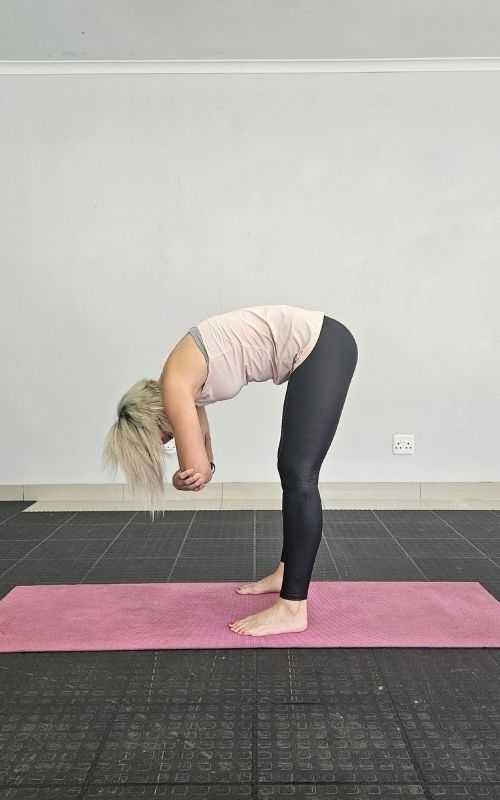
Benefit: Gently stretches hamstrings, decompresses spine, quiets the mind.
- Begin in an upright standing position with your feet hip-width apart, maintaining good alignment with your head, shoulders, hips, and legs.
- Tighten your core and hinge through your hips to lower your upper body downward.
- Hold your elbows and gently sway your upper body from side to side to deepen the stretch.
Feel the shift: This inversion helps reduce cortisol and clears your head fast.
6. Figure 4 Hip Stretch
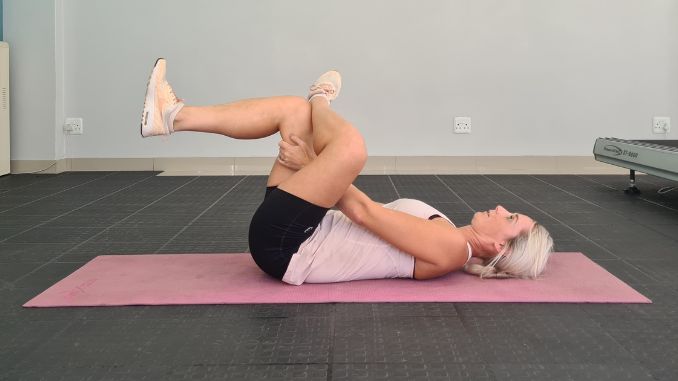
Benefit: Eases hip tension and improves lower back mobility. [3]
- Lie on the floor with your knees bent and your feet wider than hip-width apart, ensuring alignment across your head, shoulders, and hips.
- Cross one ankle over the opposite knee and flex your foot.
- Lift both legs and hold onto your bottom leg with both hands.
- Pull your bent legs closer to your body to intensify the stretch, and hold this position for several deep belly breaths, in through your nose and out through your mouth.
Important for desk sitters: Tight hips often lead to a tight lower back. This stretch targets both.
7. Child’s Pose with Extended Arms

Benefit: Deeply calming, opens hips and shoulders, soothes the nervous system.
- Begin in an upright kneeling position on the floor with your knees closed together, maintaining good alignment with your upper body.
- Tighten your abdominal area, shift your hips back to your feet, and extend your arms in front or place them on the sides.
- Lower your forehead to the floor while allowing your arms to extend fully for a deeper stretch.
- Hold this position for several deep belly breaths, in through your nose and out through your mouth.
Final reset: Think of this as your body’s natural “reset button.” Use as needed, especially when you need fast and effective stretching for stress relief.
Build a Ritual That Works
Don’t treat these moves as a checklist—use them as a toolbox. A few minutes in the morning, during a break, or before bed can help unravel the tension you’ve been carrying and create a more flexible, resilient body and mind. They’re ideal for incorporating more stretching for stress relief into your everyday wellness habits.
Final Thoughts: Small Moves, Big Impact
Stress manifests not only mentally but also physically—in your muscles, breathing, and posture. However, the good news is that your body also holds the key to releasing that stress.
These 7 simple movements aren’t just flexibility boosters—they’re daily tools for reclaiming calm, control, and comfort in your own body. You don’t need fancy equipment, painful poses, or hours. Just a few mindful minutes of stretching for stress relief can make a big difference.
So the next time tension creeps in, try one of these moves. Your future self—looser, lighter, and far less stressed—will thank you.
FAQ’s
What are the best stretches to reduce stress quickly?
Stretches such as Child’s Pose, Cat-Cow, and Supine Twist are particularly effective in alleviating stress quickly. They calm the nervous system, improve breathing, and release muscular tension—all in just a few minutes.
Can stretching help with anxiety or stress?
Yes. Stretching activates the parasympathetic nervous system (the “rest and digest” mode), which helps lower cortisol levels and reduce anxiety. When combined with deep breathing, the calming effects are even greater.
How often should I do these stress-relieving stretches?
Performing these stretches 3–5 times per week can yield noticeable benefits. For best results, aim for 10–15 minutes a day—especially during high-stress times or after sitting for long periods.
Are these stretches safe for older adults or beginners?
Absolutely. These movements are low-impact, joint-friendly, and easy to modify. They’re ideal for beginners, seniors, or anyone dealing with stiffness, injury recovery, or limited mobility.
What’s the difference between flexibility stretches and yoga?
Flexibility-focused stretches are typically simpler and target specific muscle groups to relieve tension. Yoga, while also helpful, often includes more complex sequences and a spiritual or meditative component. The moves in this post are practical, fast, and focused on stress relief and mobility.
References:
1. Extensibility and stiffness of the hamstrings in patients with nonspecific low back pain☆,☆☆
Author links open overlay panel
Jan P.K. Halbertsma PhD, Ludwig N.H. Göeken MD, PhD, At L. Hof PhD, Johan W. Groothoff PhD, Willem H. Eisma MD
https://doi.org/10.1053/apmr.2001.19786
2. Longitudinal Risk Factors for Persistent Fatigue in Adolescents Russell M. Viner, FRCPCH, FRACP, FRCP, PhD; Charlotte Clark, PhD; Stephanie J. C. Taylor, MD; et al
3. Management of the stiff shoulder Published: November 1999 Volume 4, pages 462–471, (1999) Cite this article

